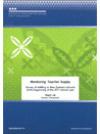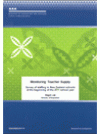The Research Division of the Ministry of Education conducts the Survey of Staffing annually to provide the Ministry with a snapshot of the number of entitlement staffing vacancies and re-advertised vacancies in schools at the start of Term 1. In 2011, the survey was completed by 90% of all state and state-integrated schools.
Key Results
The Research Division of the Ministry of Education conducts the Survey of Staffing annually to provide the Ministry with a snapshot of the number of entitlement staffing vacancies1 and re-advertised vacancies in schools at the start of Term 1. In 2011, the survey was completed by 90% of all state and state-integrated schools.
Vacancies in New Zealand schools at the beginning of the 2011 school year represented just 0.5% of all entitlement positions. Although the proportion of teacher vacancies had increased slightly compared with last year (0.4% in 2010), there were still fewer vacancies than had been in the 2004-2009 period (0.8% in 2009, 0.9% in 2005 to 2008 and 1.1% in 2004).
Different patterns in teacher vacancies over the past three years were evident for primary and secondary schools. Vacancies in primary schools decreased for the third consecutive year (0.4% in 2011, 0.5% in 2010 and 0.7% in 2009). Over the past eight years, the proportion of vacancies in the primary sector has been consistently trending downward. Vacancies in secondary schools (0.6% in 2011) were slightly higher than they were last year (0.4% in 2010). Despite this increase, vacancies in secondary schools remained lower than they had been at any time between 2004 and 2009 (0.8% in 2009, 1.1% in 2008, 1.0% in 2005-2007 and 1.4% in 2004). The subject areas with the highest number of vacancies in secondary schools were mathematics and statistics and Māori (Te Reo Māori and Māori Medium/bilingual).
Re-advertised positions in schools are considered to be an indication of ‘hard-to-staff’ positions. In 2011, just over one-third (39%) of all entitlement vacancies at the beginning of Term 1 had been re-advertised. These re-advertised vacancies represented 0.2% of all FTTE entitlement positions, a slight increase from 0.1% in 2010. Consistent with ongoing trends, vacancies and re-advertised vacancies (as a proportion of all entitlement positions) were greatest in rural schools (population <1,000), schools with the highest proportion of Māori students on their roll, and low decile schools (1-3).
The survey also examined other sources of teacher supply for New Zealand schools, including the recruitment of first and second year (beginning) teachers and overseas-trained teachers. Consistent with previous years, just over half (53%) of primary schools and the majority (83%) of secondary schools had first and/or second year beginning teachers on & their staff in 2011. Beginning teachers in the primary sector have declined in number over the past four years. Beginning teachers comprised 7.1% of the teaching population in primary schools in 2011 (compared with 7.8% in 2010, 8.6% in 2009, and 9.3% in 2008). The number of beginning teachers in the secondary sector has fluctuated over the last four years (7.2% of the teaching population in 2001, 6.6% in 2010, 6.2% in 2009 and 7.6% in 2008).
The number of overseas-trained teachers has also been trending downward. In 2011, primary and secondary schools employed 422 overseas-trained teachers who began teaching in New Zealand in 2010 or 2011. This is a notable decrease in the equivalent number of overseas-trained teachers from 2010/2009 (537 teachers) and 2009/2008 (693 teachers).


